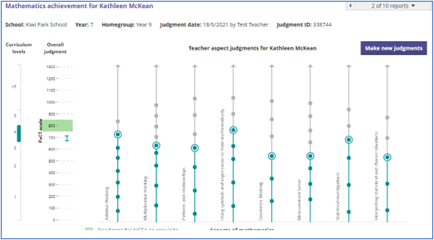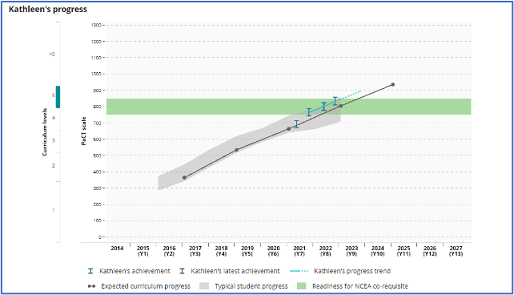Improving teaching and learning using a progression-based framework – five things I’ve learnt
By Nadine Sorrensen on August 29, 2023 in Assessment tools
Nadine has been supporting many schools to implement the Curriculum Progress Tools in reading, writing and maths over the past few years. She shares five ways the progression-based frameworks have improved teaching programmes and student learning outcomes.
The Curriculum Progress Tools (CPTs) are a Ministry of Education tool that supports dependable and consistent judgments on progress of students in reading, writing and maths. They are not something you ‘do’ with students, but something that supports teachers to know what to notice and recognise when observing student learning. The Curriculum Progress Tools include the Learning Progression Frameworks (LPF) and the Progress and Consistency Tool (PaCT). The LPFs use illustrations and descriptors to define progress across aspects for reading, writing and maths. The PaCT makes sense of the judgments against the aspects of each framework and generates reports in relation to curriculum levels.
Over the past few years, I have supported many schools to implement the Curriculum Progress Tools in reading, writing and maths. While working with teachers and leaders, I have noticed five ways these progression-based frameworks have improved teaching programmes and student learning outcomes. Outlined below is how these tools can improve the skills of teachers and provide greatly increased confidence in judgments being made.
1. Strengthens teacher knowledge of curriculum and progress
Using LPFs strengthens teacher curriculum knowledge. Teachers gain a great understanding of the breadth and depth of learning by interacting with the illustrations. It helps them understand what each stage of the progression looks like, what it looks like in authentic learning contexts, and what it is they should be noticing.
The illustrations allow teachers to compare what they have observed from their students with illustrations that exemplify similar learning. This enables them to get a sense of the increase in the sophistication of student response required to move to the next signpost. The illustrations also provide clear guidance on what should be noticed in student work and during observations and discussions, often through the bolding of keywords in the annotation section.
Each signpost has a set of illustrations that cover the breadth of learning that is possible within each stage of the progression. This supports teachers to think more widely about the potential learning opportunities that can take place for each aspect of the frameworks.
Significantly, the illustrations also highlight to teachers where they are providing sufficient opportunities for students to learn, practise and demonstrate specific learning, and where they are falling short in their programmes of learning. Many teachers reflect that they can easily recognise omissions in their learning programme.
2. The illustrations model rich, authentic learning tasks
While the main purpose of the illustrations is to support teachers with consistent judgment making, the illustrations also provide high quality examples of rich learning experiences for students. This does not mean teachers replicating the tasks in their own class, but they do provide a great source of inspiration for similarly highly engaging activities. Many teachers say they wish they had been shown these years ago!
3. Supports focused judgment making
Teachers need to make judgments against the aspects of the relevant framework. The evidence they curate on students can normally occur naturally within the classroom programme. We call this ‘natural harvest’ and can include multiple sources of evidence. Occasionally teachers will set specific tasks or ask deliberate questions to better understand the current level of student progress.
This deliberate focus on aspects of the frameworks supports a more dependable approach to judgments, and ultimately reporting of student progress. For example, the bolded words in the annotations for each illustration highlight significant indicators, things students need to exhibit to be best described at that signpost along the progression.
4. Common way of viewing learning and progression across the school
While the illustrations and annotations support more dependable judgments for a single teacher, they also create a common set of foci for teachers to make judgments against. By doing this a sense of shared understanding is developed within a school. This creates consistency in approach as students' progress is being judged against a common set of indicators. This creates consistency, dependability and reliability from year to year for teachers and parents to track and monitor progress of students. An example can be seen through the writing framework below.
The writing framework

5. Effective use of data – utilising the suite of reports available on the Progress and Consistency Tool (PaCT)
Once teachers have made judgments against aspects of an LPF framework, they enter them into PaCT. The PaCT combines the judgments made against the aspects of a framework to provide an overall picture of student progress through a detailed suite of reports. An overall judgment for each student made against the levels of the New Zealand curriculum. These reports can focus on individual students, groups of students (e.g. classes, cohorts) and whole school data.
Teachers and leaders can use these reports and this information to great effect. It generates data that can be analysed and critiqued to understand:
what progress has been made (since the last judgment)
where progress has been made (which aspects have you seen shift)
whether sufficient or accelerated progress has been made (rate of progress)
what areas do individual groups or the school do well in or needs more focus
the achievement and progress patterns across groups or the whole cohort
next steps for goalsetting and individual and/or group plans.
The diagrams below show achievement and progress data for an individual student.


As you may be aware now, I am very fond of the CPTs. This is simply because I have seen them make a real difference to teacher knowledge and confidence and the quality of information being generated,used and shared. Go and have a look for yourself! You can find all the information here on the Curriculum Progress Tools pages of the MOE website.
References
Ministry of Education. Curriculum Progress Tools: Supporting Progress
Ministry of Education. The Learning Progression Frameworks
Ministry of Education. The Progress and Consistency Tool (PaCT)
Keen to find out more? Contact
Other articles you might like
Garry offers 8 tips to help you get the best out of e-asTTle script marking in the most efficient and professional way possible.
Evaluation can make a significant contribution to improving education outcomes. In this blog Dr Melanie Atkinson shares steps to build internal evaluative capability and practices within schools.
